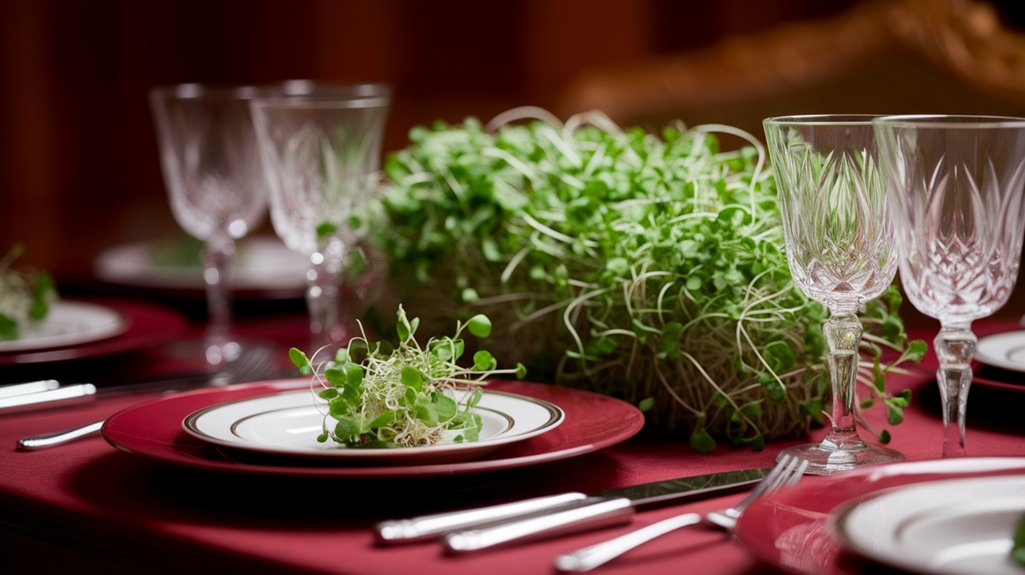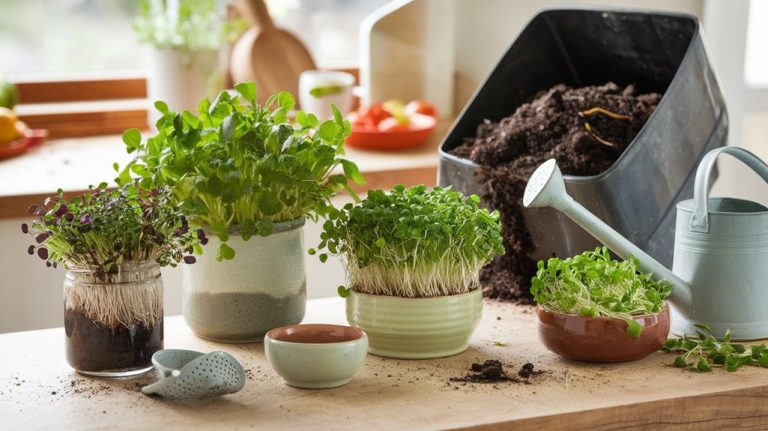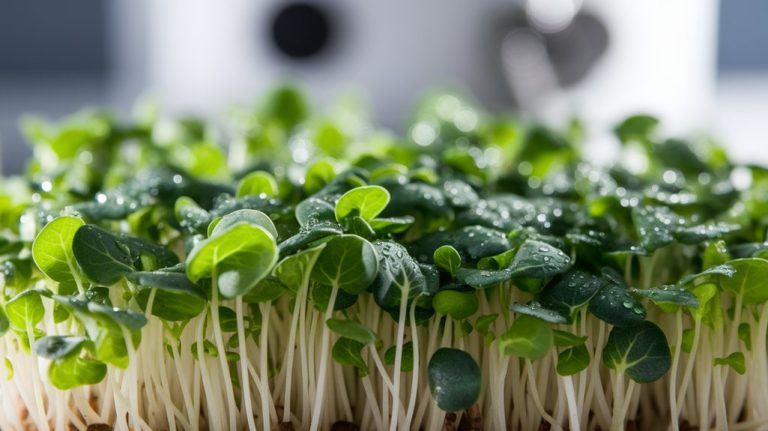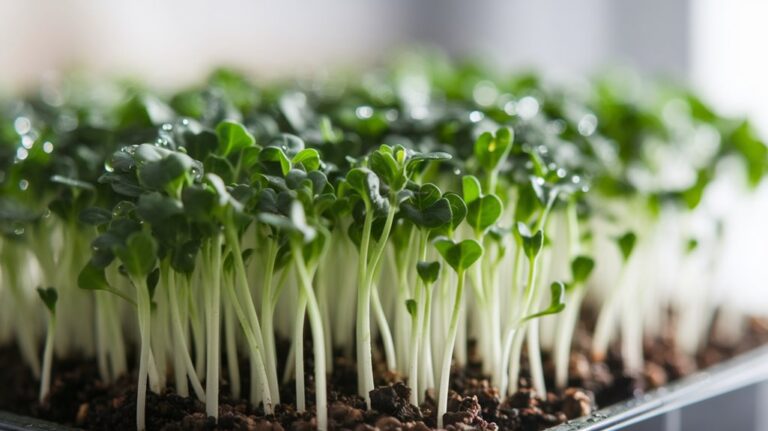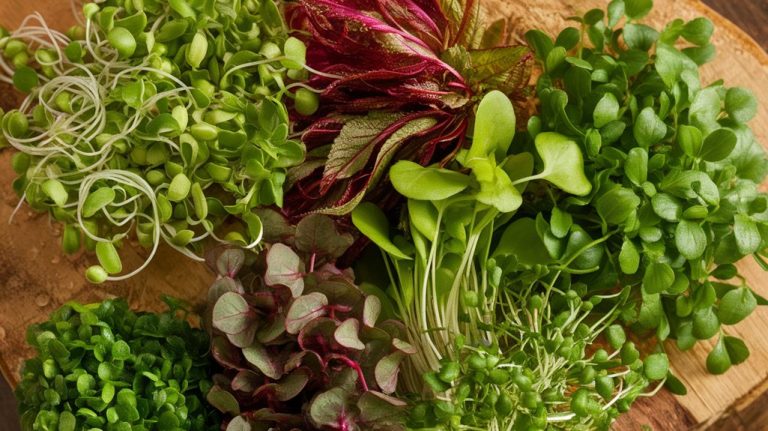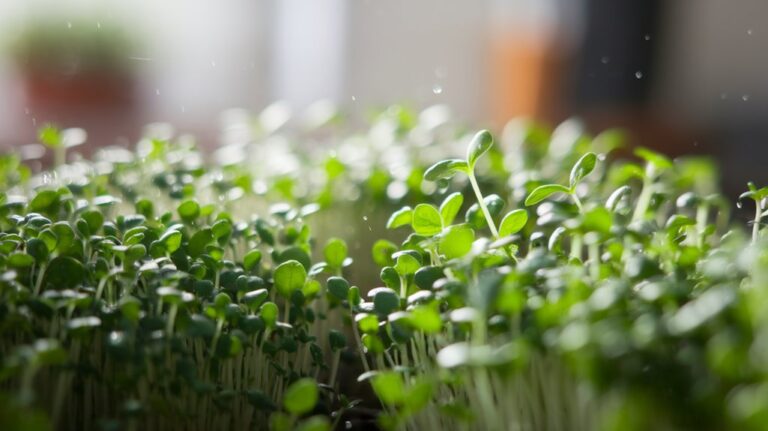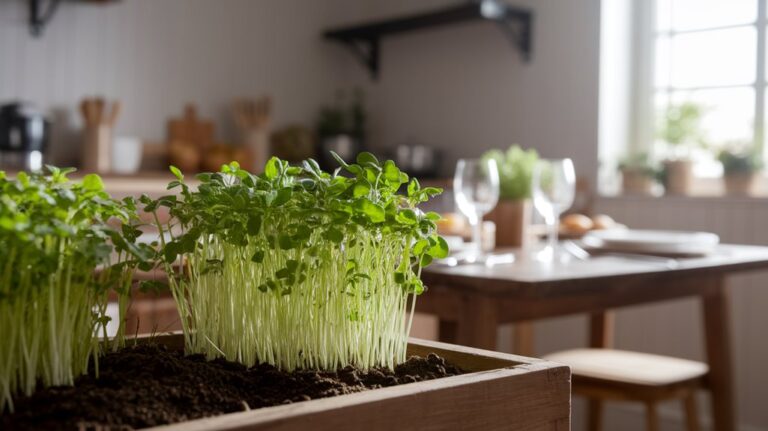Holiday Table Upgrade: Using Microgreens for Garnish & Flavor
I love using microgreens to elevate my holiday table! These tiny powerhouses burst with flavor and nutrition, making them perfect for garnishing dishes. I often choose peppery arugula, sweet pea shoots, and aromatic basil microgreens to enhance my meals. They not only add a pop of color but also bring unique tastes that delight the palate. Whether I’m sprinkling them on appetizers or salads, they create a stunning visual appeal. Discover even more ways to impress your guests!
Key Takeaways
- Microgreens add vibrant colors and textures, enhancing the visual appeal of holiday dishes on your table.
- Use arugula or radish microgreens for a peppery kick that elevates the flavor of savory meals.
- Sweet pea shoots and basil microgreens provide fresh, aromatic notes perfect for garnishing salads and appetizers.
- Experiment with combinations of microgreens for unique flavor profiles and creative presentations on holiday plates.
- Incorporate nutrient-rich microgreens to transform ordinary dishes into nutritious powerhouse offerings during festive gatherings.
Understanding Microgreens: What They Are and Their Benefits
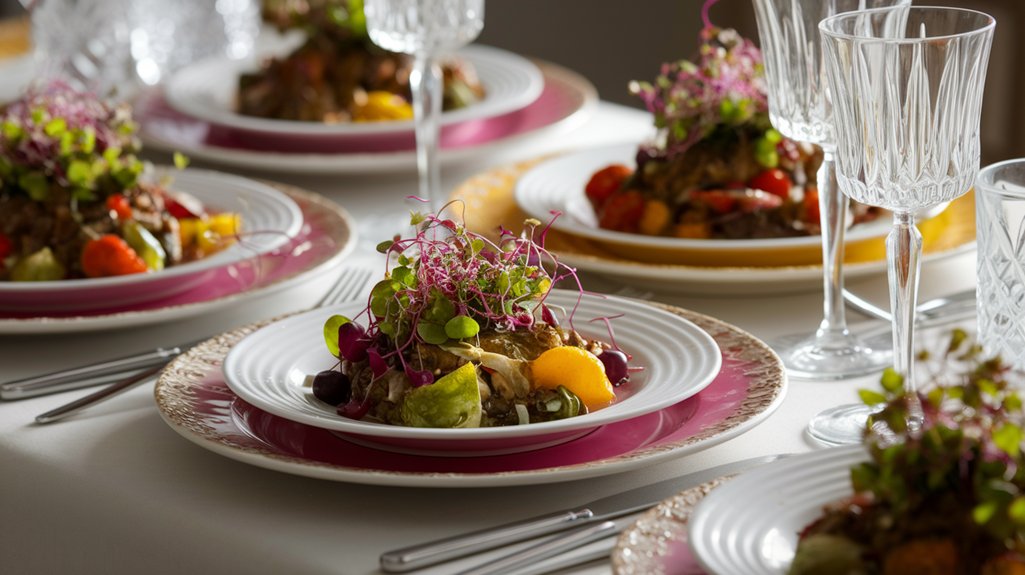
Microgreens are tiny, vibrant plants that pack a punch of flavor and nutrition. I’ve discovered that these delicate greens, harvested just after the first true leaves appear, come in a variety of colors and textures.
They’re not just pretty—they’re loaded with vitamins, minerals, and antioxidants, often containing more nutrients than their mature counterparts. I love how easily they elevate any dish, adding a burst of flavor and a pop of color.
Plus, they’re simple to grow at home, thriving on a sunny windowsill or countertop. Whether you’re sprinkling them over a salad or garnishing a gourmet plate, microgreens offer a fresh, zesty kick that’s hard to resist.
Trust me, once you try them, you’ll want to incorporate them into every meal!
Popular Types of Microgreens for Holiday Dishes
When it comes to enhancing holiday dishes, choosing the right microgreens can make all the difference. I love incorporating varieties like arugula, with its peppery bite, to elevate a simple salad.
Pea shoots add a sweet crunch, perfect for garnishing savory dishes or soups. Basil microgreens bring a fresh, aromatic quality that brightens up any plate, while radish microgreens add a zesty kick that pairs beautifully with richer foods.
For a touch of elegance, I often opt for sunflower microgreens; their nutty flavor and vibrant green color create a stunning visual contrast.
Each type of microgreen offers unique flavors and textures, making them versatile additions to my holiday spreads. It’s truly amazing how these tiny greens can transform a dish!
How to Choose the Right Microgreens for Your Menu
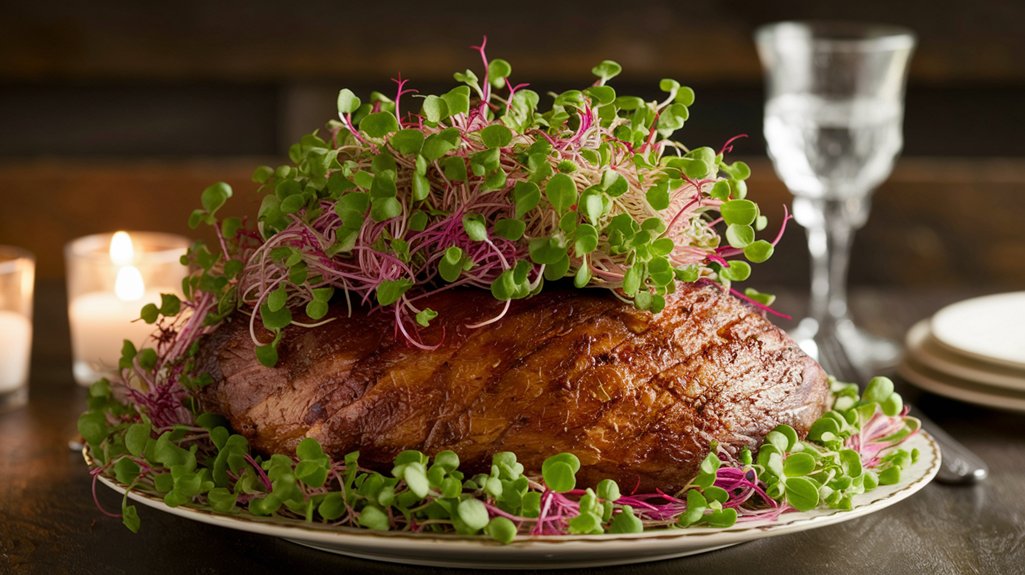
When I’m choosing microgreens for my menu, I always consider their flavor profiles first, as they can really elevate a dish.
Visual appeal is equally important; a vibrant garnish can make a plate pop and entice diners.
Plus, I can’t overlook the nutritional benefits these tiny greens pack, adding value to my offerings while keeping them delicious.
Flavor Profiles Matter
Choosing the right microgreens for your menu can make all the difference in elevating a dish’s flavor and presentation.
With so many varieties available, it’s essential to match their flavors with your dishes. Here are some microgreens to consider:
- Basil: Adds a sweet, aromatic touch, perfect for Italian dishes.
- Cilantro: Offers a fresh, citrusy flavor that pairs well with spicy foods.
- Radish: Brings a peppery kick that complements salads and sandwiches.
- Pea Shoots: Provide a sweet, earthy taste, ideal for enhancing stir-fries.
- Mustard Greens: Impart a bold, zesty flavor that can elevate meats and roasted vegetables.
Visual Appeal Considerations
Microgreens can be a feast for the eyes as much as they’re for the palate. When picking the right microgreens for your menu, I focus on colors, textures, and shapes. Vibrant greens like arugula add a fresh pop, while purple basil offers a striking contrast.
I love mixing textures too; crunchy radish greens alongside soft pea shoots can create a delightful visual interplay.
Consider the overall theme of your dish; for a rustic meal, earthy microgreens like beet greens may complement beautifully. On the other hand, for a modern dish, delicate and finely cut microgreens like cilantro or dill can elevate the plate.
Ultimately, I believe that the right microgreens not only enhance the dish’s appearance but also invite guests to indulge.
Nutritional Benefits Overview
While I appreciate the visual allure of microgreens, their nutritional benefits are equally compelling when deciding which ones to incorporate into my menu.
These tiny powerhouses pack a punch, enhancing both flavor and health. Here’s what I look for when choosing microgreens:
- Nutrient Density: Many microgreens contain higher concentrations of vitamins and minerals than their mature counterparts.
- Antioxidants: They’re rich in antioxidants, helping to combat oxidative stress.
- Flavor Profiles: Each variety offers unique flavors, from peppery to sweet, enhancing dishes.
- Digestive Health: Their fiber content supports digestion and gut health.
- Versatility: They can be used in salads, garnishes, or as a vibrant topping for various dishes.
Incorporating them into my menu not only elevates the dish but also promotes well-being.
Creative Ways to Use Microgreens as Garnishes

When I think about using microgreens as garnishes, I get excited about the endless flavor combinations and stunning presentations.
Pairing peppery arugula with sweet basil can elevate any dish, while a sprinkle of vibrant red cabbage microgreens adds a pop of color.
Let’s explore how to make your plates not just taste amazing, but look irresistible too!
Flavorful Microgreen Combinations
Although garnishing dishes might seem like a simple task, the right combination of microgreens can elevate a meal from ordinary to extraordinary.
I’ve discovered that pairing different microgreens not only enhances visual appeal but also adds a burst of flavor. Here are some combinations I love:
- Basil and Arugula: Great for Italian dishes.
- Radish and Mustard Greens: Adds a peppery kick to salads.
- Pea Shoots and Cilantro: Perfect for Asian-inspired meals.
- Sunflower and Beet Greens: Sweet and nutty, ideal for grain bowls.
- Chive and Dill: A fresh touch for seafood dishes.
These combinations bring out the best in your dishes, turning each bite into a delightful experience.
Give them a try, and you’ll be amazed at the difference!
Eye-Catching Presentation Ideas
Microgreens can transform any dish into a visual masterpiece, and I love experimenting with creative ways to showcase them. Whether you’re garnishing soups, salads, or main courses, these tiny greens add a burst of color and texture. Here are some of my favorite presentation ideas:
| Dish Type | Microgreens to Use | Presentation Tip |
|---|---|---|
| Soup | Pea Shoots | Sprinkle on top for height |
| Salad | Radish Microgreens | Layer in between ingredients |
| Main Course | Basil Microgreens | Create a vibrant bed underneath |
Enhancing Flavor Profiles With Microgreens
While exploring new culinary techniques, I often find that microgreens can transform a dish into something extraordinary. Their vibrant colors and intense flavors add depth that elevates any meal.
Here’s how I’ve enhanced my flavor profiles using these tiny powerhouses:
- Basil Microgreens: Perfect for adding a sweet, aromatic note.
- Radish Microgreens: Impart a peppery kick that livens up salads.
- Pea Shoots: Offer a fresh, crisp taste reminiscent of spring.
- Cilantro Microgreens: Bring a zesty, citrusy flavor that brightens dishes.
- Sunflower Microgreens: Add a nutty richness that complements heartier meals.
Incorporating these microgreens not only beautifies your plate but also enriches the overall tasting experience, making every bite memorable.
Incorporating Microgreens Into Appetizers
There’s something truly delightful about adding microgreens to appetizers that can elevate even the simplest bites.
I love to sprinkle vibrant radish microgreens over creamy goat cheese crostini; their peppery flavor adds a wonderful contrast. For a fresh twist, I often incorporate pea shoots in spring rolls, giving them a crunchy texture and a burst of sweetness.
You can’t go wrong with classic bruschetta topped with basil microgreens, which enhance both the flavor and visual appeal.
Even a simple cheese platter becomes extraordinary with a handful of microgreens tossed in.
Whatever your choice, these tiny greens not only add a pop of color but also introduce exciting flavors, making your appetizers unforgettable.
Elevating Main Courses With Microgreens
When I think of elevating my main courses, microgreens instantly come to mind as the perfect flavorful garnish.
Not only do they add a burst of color and taste, but their nutritional benefits are also a wonderful bonus to any dish.
Let’s explore how these tiny greens can transform your meals into culinary masterpieces.
Flavorful Garnishes for Dishes
Microgreens, with their vibrant colors and intense flavors, can transform a simple dish into a culinary masterpiece. I love using them to elevate my main courses, and here’s why you should consider them too:
- Peppery arugula adds a bold kick to roasted meats.
- Cilantro microgreens bring a fresh, zesty brightness to tacos.
- Radish microgreens offer a crisp, peppery crunch that complements salads beautifully.
- Basil microgreens infuse a lovely aromatic sweetness into pasta dishes.
- Sunflower shoots provide a nutty flavor that pairs well with grain bowls.
These tiny greens aren’t just for looks; they pack a punch of flavor that can elevate your dishes and impress your guests.
Give them a try, and watch your meals come alive!
Nutritional Benefits of Microgreens
While enhancing the visual appeal of your dishes, microgreens also pack a surprising nutritional punch that can significantly elevate your meals.
These tiny greens are loaded with vitamins, minerals, and antioxidants, often containing higher concentrations than their mature counterparts. For instance, a sprinkle of kale microgreens on your plate can provide a boost of vitamins A, C, and K, promoting overall health.
Not only do they enrich your dishes with flavor, but they also contribute to a balanced diet. Imagine incorporating peppery arugula microgreens into your salad, adding both crunch and essential nutrients.
It’s an effortless way to transform ordinary meals into powerhouse dishes that nourish your body while tantalizing your taste buds. So, don’t underestimate these little wonders!
Adding Microgreens to Holiday Desserts
As I explore the world of holiday desserts, I can’t help but marvel at how microgreens can elevate these sweet treats in unexpected ways. They add a splash of color, a burst of flavor, and a hint of sophistication.
Here are some delightful ways to incorporate them:
- Garnish on cakes and cupcakes for a vibrant touch.
- Infusion in mousse for a refreshing twist.
- Sprinkled atop fruit tarts to enhance visual appeal.
- Blended into frostings for a unique flavor profile.
- Layered in parfaits for added texture and nutrition.
Microgreens can transform classic desserts into memorable experiences, impressing your guests while delighting their taste buds.
Don’t shy away from experimenting; the results can be truly enchanting!
Tips for Growing Your Own Microgreens at Home
After enjoying the vibrant flavors of microgreens in your holiday desserts, you might find yourself eager to grow your own at home. It’s easier than you think!
Start with a shallow container, fill it with quality potting mix, and spread your chosen seeds evenly. I love using varieties like radish, basil, or arugula for their robust flavors. Mist the soil to keep it moist, and cover the seeds lightly with soil.
Place your container in a sunny spot or under grow lights. Within a week, you’ll see tiny greens sprouting! Harvest them once they reach about two inches tall. Use scissors to snip them just above the soil. Enjoy the satisfaction of fresh microgreens elevating your dishes!
Presenting Your Holiday Table With Style and Elegance
Creating a beautifully presented holiday table transforms any meal into a memorable event. I love to focus on details that elevate the dining experience, and using microgreens is one of my favorite tricks. Here’s how I do it:
- Choose a theme: Select colors and styles that reflect the season.
- Layer textures: Use table linens, plates, and glassware with varying materials for visual interest.
- Incorporate height: Arrange dishes at different levels to create depth.
- Add microgreens: Use them as vibrant garnishes for an elegant touch.
- Finish with decor: Fresh flowers or candles add warmth and charm.
Frequently Asked Questions
Can Microgreens Be Grown Indoors Year-Round?
Absolutely, I’ve found that microgreens can thrive indoors year-round!
With just a few essentials—a sunny windowsill or grow lights, quality soil, and some seeds—you can cultivate vibrant greens in any season.
I love how quickly they sprout, usually within a week. Not only do they add freshness to my meals, but they also brighten up my space.
Give it a try; you’ll be amazed at how easy and rewarding it is!
Are There Any Allergies Associated With Microgreens?
I’ve often wondered about allergies when it comes to microgreens.
While they’re generally safe and packed with nutrients, some folks might’ve sensitivities. Common allergens can include mustard greens and radish microgreens, which could trigger reactions in sensitive individuals.
It’s always best to start with a small amount to see how your body reacts. If you’re unsure, consulting with a healthcare professional can give you peace of mind before diving into these vibrant greens.
How Do I Store Leftover Microgreens?
Storing leftover microgreens is super easy!
I like to keep them in a breathable container, like a paper towel-lined produce bag. This way, they stay dry but can still breathe.
I make sure to keep them in the fridge, ideally in the crisper drawer, where it’s a bit humid. They’ll typically last about a week.
Each time I use them, I check for any wilting or spoilage to ensure freshness!
What Is the Shelf Life of Microgreens?
I often wonder about the shelf life of microgreens, and I’ve found they typically last about 5 to 14 days when stored properly.
It really depends on the variety and how fresh they were when I bought them.
I always keep mine in a breathable container in the fridge to maximize freshness.
If I notice any wilting or discoloration, I know it’s time to use them up or toss them out.
Can I Use Microgreens in Smoothies or Drinks?
Absolutely, you can use microgreens in smoothies or drinks! I love adding a handful of fresh microgreens for an extra nutrient boost.
They blend seamlessly, providing a subtle flavor that enhances my smoothies without overpowering them. I often mix them with fruits like bananas or berries, and the result isn’t only refreshing but also packed with vitamins.
Conclusion
As I wrap up my holiday table upgrade, I can’t help but feel excited about the vibrant touch microgreens bring to my dishes. Their unique flavors and stunning presentations elevate every meal, making even the simplest recipes feel gourmet. Whether I’m garnishing a festive appetizer or adding a fresh twist to desserts, these tiny greens have transformed my holiday dining experience. I encourage you to explore the world of microgreens and watch your table come alive with color and taste!

